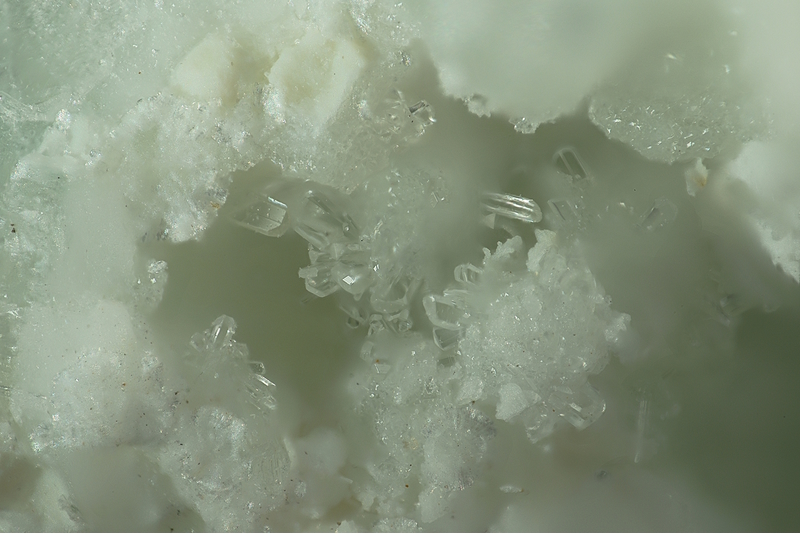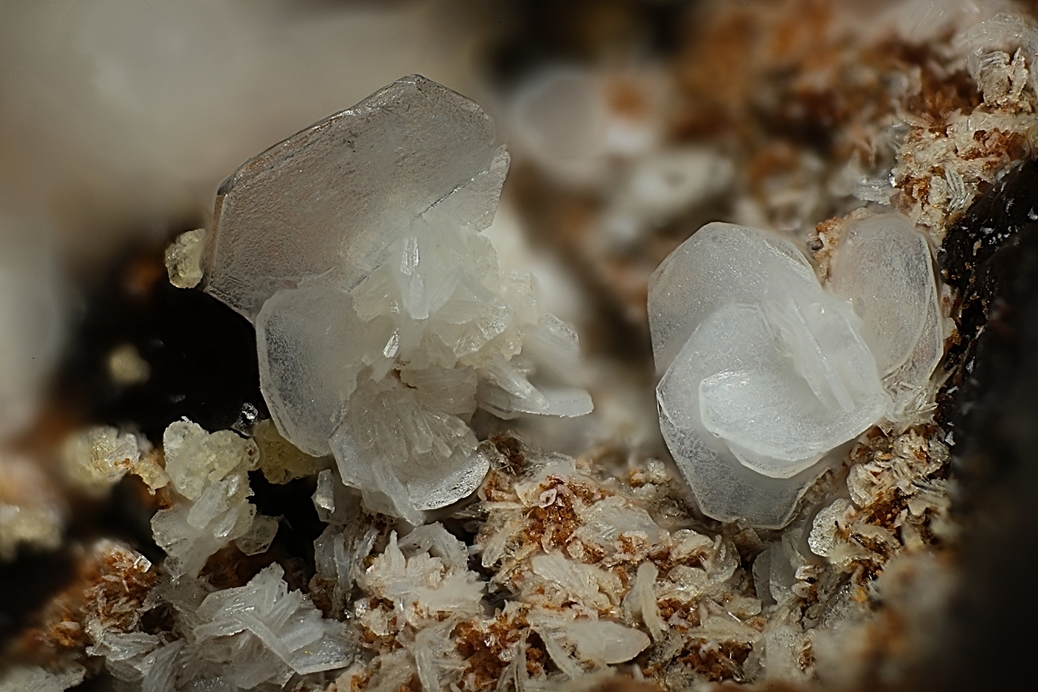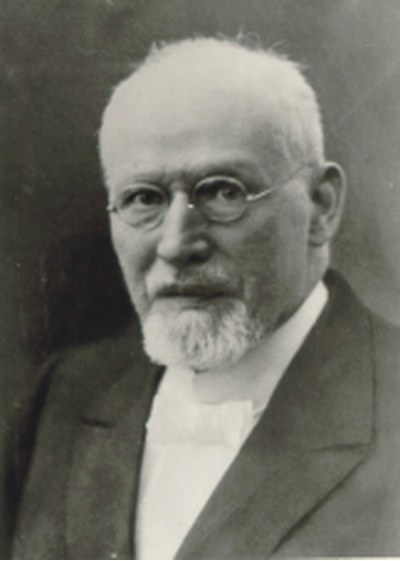Vaterite (original) (raw)
A valid IMA mineral species - grandfathered
About VateriteHide
This section is currently hidden. Click the show button to view.
Lustre:
Sub-Vitreous, Waxy
Name:
Named in honor of Heinrich August Vater [September 5, 1859 Bremen, Germany - February 10, 1930 Dresden, Germany], Professor of Mineralogy and Chemistry, Tharandt, Saxony (Germany). He was a pioneer in the areas of forest soil science, land evaluation, and forest fertilization.
A rare CaCO3 modification that is metastable below approx. 400°C. May be stabilised by sulphate (Fernández-Díaz et al., 2010).
Vaterite is actually composed of at least two different crystallographic structures that coexist within a pseudo–single crystal. The major structure (actually substructure) exhibits hexagonal symmetry; the minor structure, existing as nanodomains within the major matrix, is still unknown (Kabalah-Amitai et al., 2013). However, as suggested by Christy (2017) in his review, the most plausible polytypes to describe the structure, namely the 2_M_ and 6_H_ ones, actually "do not occur in their highest-symmetry forms", but are described by the space groups _C_121 and _P_3221, respectively.
The structure is disordered in terms of (1) different orientations of the carbonate groups, (2) different stacking sequences of the carbonate-comprising layers, and (3) possible chiral forms (Demichelis et al., 2013). The OD character leads to polytypism; the OD layer comprises Ca coordination polyhedra and halves of the carbonate groups, and the group symmetry of the layer is _C_2/m; the known stacking sequences include: _P_6122, _P_6522, _C_2/c, _C_2/_c_2/_m_21/m, and _P_312 or _P_322. The type of the OD layering is similar to those observed in bastnäsite-synchysite polysomatic series (Makovicky, 2016).
Not uncommon as a biomineral (other sources: rarely used in hard tissue). Exists in fish otoliths. As such, it is formed from the precursor - Unnamed (Amorphous Calcium Carbonate) - via dehydration (Bots et al., 2012), the transformation process being inhibited in the presence of PO43- ions (Sugiura et al., 2016). Further dissolution-reprecipitation turns vaterite into calcite. Vaterite/calcite precipitates are known in the Cladosporium fungus, too (Ye et al., 2023).
May comprise a series with bästnasite group, known as bästnasite-vaterite homologous series.
Unique IdentifiersHide
This section is currently hidden. Click the show button to view.
Long-form identifier:
mindat:1:1:4161:0
63facd26-2fc7-4d0e-b1f1-ded8df6e92d4
IMA Classification of VateriteHide
This section is currently hidden. Click the show button to view.
Approved, 'Grandfathered' (first described prior to 1959)
Classification of VateriteHide
This section is currently hidden. Click the show button to view.
5.AB.20
5 : CARBONATES (NITRATES)
A : Carbonates without additional anions, without H2O
B : Alkali-earth (and other M2+) carbonates
14.1.2.1
14 : ANHYDROUS NORMAL CARBONATES
1 : A(XO3)
11.4.3
11 : Carbonates
4 : Carbonates of Ca
Mineral SymbolsHide
This section is currently hidden. Click the show button to view.
As of 2021 there are now IMA–CNMNC approved mineral symbols (abbreviations) for each mineral species, useful for tables and diagrams.
Please only use the official IMA–CNMNC symbol. Older variants are listed for historical use only.
| Symbol | Source | Reference |
|---|---|---|
| Vtr | IMA–CNMNC | Warr, L.N. (2021). IMA–CNMNC approved mineral symbols. Mineralogical Magazine, 85(3), 291-320. doi:10.1180/mgm.2021.43 |
| Vtr | Whitney & Evans (2010) | Whitney, D.L. and Evans, B.W. (2010) Abbreviations for names of rock-forming minerals. American Mineralogist, 95, 185–187 doi:10.2138/am.2010.3371 |
Physical Properties of VateriteHide
This section is currently hidden. Click the show button to view.
Fracture:
Irregular/Uneven, Splintery
Density:
2.645 g/cm3 (Measured) 2.645 g/cm3 (Calculated)
Optical Data of VateriteHide
This section is currently hidden. Click the show button to view.
RI values:
_n_ω = 1.550 _n_ε = 1.650
δ = 0.100
Image shows birefringence interference colour range (at 30µm thickness)
and does not take into account mineral colouration.
Optical Extinction:
Parallel
Chemistry of VateriteHide
This section is currently hidden. Click the show button to view.
Crystallography of VateriteHide
This section is currently hidden. Click the show button to view.
Class (H-M):
6/m m m _(_6/_m_2/_m_2/m ) - Dihexagonal Dipyramidal
Cell Parameters:
a = 4.13 Å, c = 8.49 Å
Unit Cell V:
125.41 ų (Calculated from Unit Cell)
Morphology:
Thin fibers, spherulitic aggregates.
Comment:
Wang, J.W. & Becker, U. (2009): Structure and carbonate orientation of vaterite (CaCO3). Am. Mineral. 94, 380-386. Important note: Christy (2017) actually suggests, that the correct space groups to describe the polytypes constituting the vaterite crystals are C121 (monoclinic crystal system) and P3221 (trigonal crystal system)
Crystal StructureHide
This section is currently hidden. Click the show button to view.
Load
Unit Cell |Unit Cell Packed
2x2x2 |3x3x3 |4x4x4
Show
Big Balls |Small Balls |Just Balls |Spacefill
Polyhedra Off |Si Polyhedra |All Polyhedra
Remove metal-metal sticks
Display Options
Black Background |White Background
Perspective On |Perspective Off
2D |Stereo |Red-Blue |Red-Cyan
View
CIF File Best |x |y |z |a |b |c
Rotation
Stop |Start
Labels
Console Off |On |Grey |Yellow
| ID | Species | Reference | Link | Year | Locality | Pressure (GPa) | Temp (K) |
|---|---|---|---|---|---|---|---|
| 0004854 | Vaterite | Wang J, Becker U (2009) Structure and carbonate orientation of vaterite (CaCO3) American Mineralogist 94 380-386 |  |
2009 | theoretical | 0 | 293 |
| 0009279 | Vaterite | Kamhi S R (1963) On the structure of vaterite, CaCO3 Acta Crystallographica 16 770-772 |  |
1963 | Synthetic, preferred structure model | 0 | 293 |
| 0019139 | Vaterite | Meyer H J (1959) Uber Vaterit und seine Struktur Angewandte Chemie 71 678-679 | 1959 | 0 | 293 | ||
| 0019869 | Vaterite | Demichelis R, Raiteri P, Gale J D, Dovesi R (2012) A new structural model for disorder in vaterite from first-principles calculations CrystEngComm 14 44-47 | 2012 | theoretical | 0 | 293 | |
| 0019870 | Vaterite | Demichelis R, Raiteri P, Gale J D, Dovesi R (2012) A new structural model for disorder in vaterite from first-principles calculations CrystEngComm 14 44-47 | 2012 | theoretical | 0 | 293 | |
| 0019871 | Vaterite | Demichelis R, Raiteri P, Gale J D, Dovesi R (2012) A new structural model for disorder in vaterite from first-principles calculations CrystEngComm 14 44-47 | 2012 | theoretical | 0 | 293 | |
| 0019872 | Vaterite | Demichelis R, Raiteri P, Gale J D, Dovesi R (2012) A new structural model for disorder in vaterite from first-principles calculations CrystEngComm 14 44-47 | 2012 | theoretical | 0 | 293 | |
| 0019865 | Vaterite | Demichelis R, Raiteri P, Gale J D, Dovesi R (2013) The multiple structures of vaterite Crystal Growth & Design 13 2247-2251 | 2013 | theoretical | 0 | 293 | |
| 0019866 | Vaterite | Demichelis R, Raiteri P, Gale J D, Dovesi R (2013) The multiple structures of vaterite Crystal Growth & Design 13 2247-2251 | 2013 | theoretical | 0 | 293 | |
| 0019867 | Vaterite | Demichelis R, Raiteri P, Gale J D, Dovesi R (2013) The multiple structures of vaterite Crystal Growth & Design 13 2247-2251 | 2013 | theoretical | 0 | 293 | |
| 0019868 | Vaterite | Demichelis R, Raiteri P, Gale J D, Dovesi R (2013) The multiple structures of vaterite Crystal Growth & Design 13 2247-2251 | 2013 | theoretical | 0 | 293 | |
| 0019019 | Vaterite | Le Bail A, Ouhenia S, Chateigner D (2011) Microtwinning hypothesis for a more ordered vaterite model Powder Diffraction 26 16-21 | 2011 | synthetic | 0 | 293 | |
| 0019140 | Vaterite | Le Bail A, Ouhenia S, Chateigner D (2011) Microtwinning hypothesis for a more ordered vaterite model Powder Diffraction 26 16-21 | 2011 | synthetic | 0 | 293 | |
| 0019141 | Vaterite | Le Bail A, Ouhenia S, Chateigner D (2011) Microtwinning hypothesis for a more ordered vaterite model Powder Diffraction 26 16-21 | 2011 | synthetic | 0 | 293 |
CIF Raw Data - click here to close
X-Ray Powder DiffractionHide
This section is currently hidden. Click the show button to view.
Powder Diffraction Data:
| d-spacing | Intensity |
|---|---|
| 3.57 Å | (55) |
| 3.30 Å | (100) |
| 2.73 Å | (95) |
| 2.065 Å | (60) |
| 1.858 Å | (25) |
| 1.823 Å | (70) |
| 1.647 Å | (25) |
Comments:
See also 33-268; 13-192 (synthetic)
Geological EnvironmentHide
This section is currently hidden. Click the show button to view.
Synonyms of VateriteHide
This section is currently hidden. Click the show button to view.
Other Language Names for VateriteHide
This section is currently hidden. Click the show button to view.
Relationship of Vaterite to other SpeciesHide
This section is currently hidden. Click the show button to view.
Common AssociatesHide
This section is currently hidden. Click the show button to view.
Associated Minerals Based on Photo Data:
Related Minerals - Strunz-mindat GroupingHide
This section is currently hidden. Click the show button to view.
Fluorescence of VateriteHide
This section is currently hidden. Click the show button to view.
Other InformationHide
This section is currently hidden. Click the show button to view.
Thermal Behaviour:
Dry crystals convert to calcite when heated to about 440°.
Notes:
Converts to aragonite or calcite when boiled in water. Converts to calcite when boiled in NaCl solution.
Health Risks:
No information on health risks for this material has been entered into the database. You should always treat mineral specimens with care.
Internet Links for VateriteHide
This section is currently hidden. Click the show button to view.
References for VateriteHide
This section is currently hidden. Click the show button to view.
Reference List:
Kabalah-Amitai, L., Mayzel, B., Kauffmann, Y., Fitch, A. N., Bloch, L., Gilbert, P. U. P. A., Pokroy, B. (2013) Vaterite Crystals Contain Two Interspersed Crystal Structures. Science, 340 (6131). 454-457 doi:10.1126/science.1232139
Localities for VateriteHide
This section is currently hidden. Click the show button to view.
This map shows a selection of localities that have latitude and longitude coordinates recorded. Click on the  symbol to view information about a locality. The
symbol to view information about a locality. The  symbol next to localities in the list can be used to jump to that position on the map.
symbol next to localities in the list can be used to jump to that position on the map.
Locality ListHide
This section is currently hidden. Click the show button to view.
 - This locality has map coordinates listed.
- This locality has map coordinates listed.  - This locality has estimated coordinates. ⓘ - Click for references and further information on this occurrence. ? - Indicates mineral may be doubtful at this locality.
- This locality has estimated coordinates. ⓘ - Click for references and further information on this occurrence. ? - Indicates mineral may be doubtful at this locality.  - Good crystals or important locality for species.
- Good crystals or important locality for species.  - World class for species or very significant. (TL) - Type Locality for a valid mineral species. (FRL) - First Recorded Locality for everything else (eg varieties).
- World class for species or very significant. (TL) - Type Locality for a valid mineral species. (FRL) - First Recorded Locality for everything else (eg varieties). Struck out - Mineral was erroneously reported from this locality. Faded * - Never found at this locality but inferred to have existed at some point in the past (e.g. from pseudomorphs).
All localities listed without proper references should be considered as questionable.
| Antarctica | |
|---|---|
| Eastern Antarctica Victoria Land Ross Archipelago Ross Island ⓘ Hut Point Peninsula | Browne |
| Australia | |
| Tasmania Central Highlands municipality Liawenee ⓘ Liawenee canal | Bottrill et al. (2008) |
| Austria | |
| Salzburg Zell am See District Neukirchen am Großvenediger Hopffeld area ⓘ |
42 +2 other references |
| Canada | |
| Nunavut Qikiqtaaluk Region Ellesmere Island ⓘ Borup Fiord Pass | Gleeson et al. (2011) |
| Québec Montérégie La Vallée-du-Richelieu RCM Mont Saint-Hilaire ⓘ Poudrette quarry (De-Mix quarry; Demix quarry; Uni-Mix quarry; Carrière Mont Saint-Hilaire; MSH) | HORVÁTH et al. (2000) +1 other reference |
| Saguenay-Lac-Saint-Jean Le Fjord-du-Saguenay RCM Saint-Honoré ⓘ Saint-Honoré carbonatite complex | Fournier (1993) |
| ⓘ Niobec mine | FOURNIER (1993) |
| France | |
| Occitanie Aveyron Rodez Sévérac-d'Aveyron ⓘ Lapanouse-de-Sévérac slag locality | publication date: November 2018 +1 other reference |
| Germany | |
| Baden-Württemberg Freiburg Region Ortenaukreis Oberwolfach ⓘ Clara Mine | Walenta (1995) |
| Lower Saxony Goslar District Clausthal-Zellerfeld Oberschulenberg ⓘ Glücksrad Mine | Schnorrer-Köhler (1991) |
| Rhineland-Palatinate Mayen-Koblenz Mayen ⓘ Mayener Feld | Hentschel et al. (1983) |
| Mendig Mendig ⓘ Basalt quarries | Hentschel (1983) |
| Vordereifel Ettringen ⓘ Caspar quarry | [Hentschel et al. (5) |
| Vulkaneifel Daun Üdersdorf ⓘ Emmelberg | Schüller et al. (1986) |
| Gerolstein Walsdorf Zilsdorf ⓘ Arensberg | Hentschel (1983) |
| Hungary | |
| Somogy County Marcali District ⓘ Táska | Szakáll & Gatter: Hun. Min. Spec. |
| Italy | |
| Campania Metropolitan City of Naples Ercolano San Vito ⓘ San Vito Quarry | Pavel M. Kartashov analytical data |
| Japan | |
| Hokkaidō Prefecture Tokachi Subprefecture Ashoro District Ashoro-cho (Asyoro-tyo) ⓘ Shiowakka | Ito et al. (1999) |
| Jordan | |
| Amman Governorate Transjordan Plateau Daba-Siwaqa complex ⓘ Daba | Pitty et al. (2010) |
| Irbid Governorate Maqarin area ⓘ Yarmouk river | Khoury et al. (1985) |
| Kyrgyzstan | |
| Issyk-Kul Region ⓘ Kumtor Gold Mine | Shevkunov et al. (2022) |
| Lebanon | |
| South Governorate Jezzine District ⓘ Bhanine Valley ? | Łukasz (2019) |
| Middle East | |
| ⓘ Hatrurim Formation | Gross (1977) |
| Namibia | |
| Otjozondjupa Region Otavi Constituency Kombat ⓘ Kombat Mine | ex J Lamond Micro Collection (ex Rob Sielecki) |
| New Zealand | |
| Northland Region Kaipara District Arapohue ⓘ Bee Bush Roadcut | Black |
| Otago Region ⓘ Clipper-1 | Newman (2015) |
| Palestine | |
| West Bank Jericho Governorate ⓘ Nabi Musa | Sokol et al. (2011) |
| Quds Governorate ⓘ Ma'ale Adumim | Shulamit Gross (1977) |
| Poland | |
| Silesian Voivodeship Siemianowice Śląskie ⓘ Dąbrowka Wielka | Kruszewski L. 2006: Oldhamite-periclase-portlandite-fluorite assemblage and coexisting minerals of burnt dump in Siemianowice Śląskie - Dąbrówka Wielka area (Upper Silesia, Poland) |
| Romania | |
| Brașov County ⓘ Racoş (Racoşul de Jos) | Szakáll |
| ⓘ Basalt quarry | Szakáll et al. (2010) |
| Hunedoara County Boșorod ⓘ Cioclovina cave | D. Dumitras (2000) +1 other reference |
| Russia | |
| Chelyabinsk Oblast ⓘ Chelyabinsk coal basin | Cesnokov et al. (1998) |
| Murmansk Oblast ⓘ Khibiny Massif | ... |
| Northern Karelia ⓘ Vuoriyarvi alkaline-ultrabasic massif | Belovitskaya et al. (2004) |
| Slovakia | |
| Banská Bystrica Region Banská Bystrica District Špania Dolina Špania Dolina deposit ⓘ Piesky | Mikuš T. et al. (2017) |
| ⓘ Piesky adit | Mikuš T. et al. (2017) |
| Prešov Region Vranov nad Topľou District Vechec ⓘ Vechec quarry | Zajzon N. et al. (2021) |
| South Africa | |
| Northern Cape John Taolo Gaetsewe District Municipality Joe Morolong Local Municipality ⓘ Wessels Mine | Cairncross et al. (1995) |
| UK | |
| England Derbyshire High Peak Peak Forest ⓘ Peak Dale ? | Field et al. (2016) +1 other reference |
| Northern Ireland Co. Antrim ⓘ Ballycraigy | McConnell (1960) +1 other reference |
| USA | |
| Arizona Maricopa County ⓘ Phoenix area | Anthony et al. (1995) |
| Illinois Hardin County ⓘ Cave-in-Rock Mining Sub-District | Excalibur Mineral Company specimen |
| Michigan Houghton County Calumet Township Osceola ⓘ Osceola Mine | Heinrich et al. (2004) |
| New Mexico Otero County Cornudas Mountains ⓘ Wind Mountain | XRD - Laszlo Horvath collection |
| Tennessee Smith County Carthage ⓘ Elmwood Mine | www.excaliburmineral.com |


